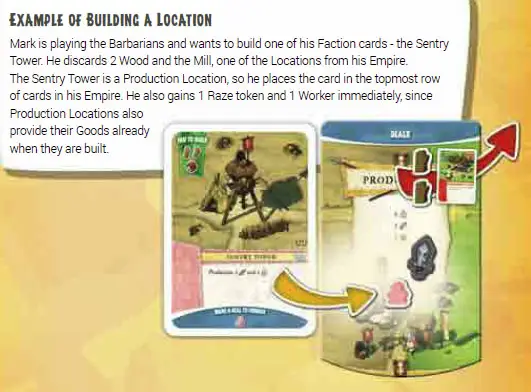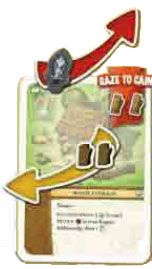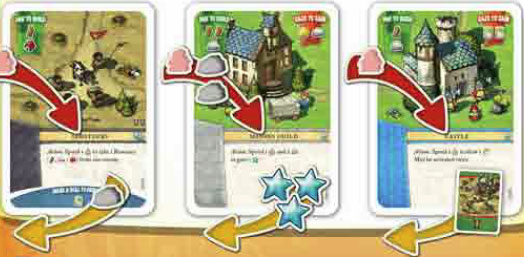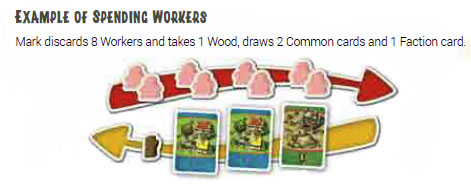
Every time a Location gives you VPs, immediately adjust your score on the Victory Point track.
Gold tokens can be used instead of any Resource (Wood, Stone, Food), but not the other way around. Gold tokens cannot be exchanged for Resource markers.
Each time you receive Resources, Workers or tokens, you should take them from the general supply, unless stated otherwise.
Whenever you discard Resources, Workers or tokens, they are returned to the general supply.
Resources, Workers and tokens in a player's supply must be visible to all players.
Whenever you are allowed to draw a card, you can either draw it from the Common deck or the Faction deck, unless stated otherwise.
Each type of card should be discarded to its own respective discard pile. If you ever run out of cards in any deck, reshuffle the appropriate discarded pile to create a new deck.
Card rules take precedence over and modify the general rules.
Build a location
This action allows a player to place Common or Faction cards from their hand into their playing area to improve their Empire.
In order to build a location a player has to:
- Choose the card from his hand that he wants to build.
- Pay the building cost depicted in the card's upper left corner using the indicated Goods from his personal supply.
- Place the card in his Empire following the Location placement order.
Note 1: When you build a Production Location, you immediately gain the benefits the Location provides.
Note 2: Some of the Locations can have a special Bonus ability that grants the player one-time-only Goods when the Location is built.
Building Costs

To build a Common Location, a player only needs to discard certain resources like Wood and/or Stone. For example, to build a Wood Storage, the player has to discard 2 Wood and 1 Stone..
To build a Faction Location, a player may need to have another Location already built in his Empire. Many Faction Locations require the Building player to discard a Built Location (Common or Faction) from his Empire.
This is in addition to the other Resource costs depicted on the Faction Location. Only after paying the cost can he place the card in his Empire following the Location placement order.
For example, to build a Barbarian Dark Chapel the player must discard 1 previously built Location card in his play area, as well as 1 Wood and 2 Stone.
Note 1: To build a Faction Location, a player can also discard a Foundation (more on the Raze a Location action on page 9) instead of a Location.
Note 2: To build a Faction Location, a player may discard an Action Location which has previously been activated in the current round. The Goods used to activate the Action are also discarded.
Note 3: If there are any tokens or markers placed on the card which you discard (e.g. Defense tokens, Samurai, Goods spent to activate the Action), they are discarded too.
Location Abilities
Based on their abilities, both Common and Faction Locations are divided into 3 groups:
Production Locations - these cards give the player specific Goods (Resources, Workers, cards, tokens, VPs) depicted in the card's ability field. You gain the benefits immediately once such a Location is built and during each Production phase of the following rounds.
Feature Locations - these cards can have different special abilities described on the cards. They are active during the owning player's entire turn, or grant him Goods after taking certain actions.
Action Locations - in order to use the Location's ability, a player has to place his Worker, or a specific Resource, or both on the Location card.
Note 1: Several Locations can also have a Building Bonus which is only an additional one-time ability with no influence on the Location placement.

Make a deal
This action allows a player to make a deal with a Faction card from their hand.
Note: A player cannot Make a Deal with a Common card.
Each Faction card has a Deal field which indicates what kind of Goods (Resources, Workers, cards, etc). it provides. Deals provide various benefits to the player immediately after performing the action and during the Production phase of each following round.
In order to make a deal, a player has to:
- Choose a Faction card from his hand.
- Discard 1 Food.
- Place the card under the top of his Faction board. The card should be placed in such a manner that only the Deal field of the card is visible.
- Immediately gain the Good the Deal provides.

There is no limit to the number of Deals a player may have.
Example of Making a Deal
Mark is playing the Barbarians and wants to Make a Deal using the Sentry Tower. He discards 1 Food and places the Village card under his Faction board, so only the Deal field, with the Worker in this case, is visible. He immediately takes 1 Worker from the general supply, since making a Deal provides that player with a Good.
Raze
This action allows a player to Raze a Common Card from his hand or an opponent's Common Location to immediately gain some Goods.
A player can only use this action if he has Raze tokens.
In order to raze a common card from hand:
- Select a Common card from his hand.
- Discard 1 Raze token.
- Take from the general supply the Goods depicted in the Raze field of the card.
- Discard the card.

Note: The player commanding the Japanese can also raze a Faction Location from his hand, for Japanese Faction cards have a Raze field.
Example of Razing a card from hand
Mark wants to raze one of his cards from his hand. He needs Wood, so he chooses the Wood Storage and discards the card along with 1 Raze token. As a result, Mark receives 2 Wood from the general supply.
In order to raze an opponent's location:
- Choose an enemy and any one of his Common Locations in his Empire.
- Discard 2 Raze tokens.
- Take from the general supply the Goods depicted in the Raze field of the card.
- Turn the razed Location into a Foundation.
Note: Faction locations cannot be razed, with the exception of Japanese Faction cards. Japanese Faction cards do have a Raze field, so they can be razed by another player. Razed Japanese Faction Locations are not turned into a Foundation, but are discarded instead.
Example of Razing an opponent's Location
Mark wants to raze one of Tom's Locations. He chooses to attack the Armorer, so he discards 2 Raze tokens. As a result, Mark receives 1 stone from the general supply and adjusts his score by adding 1 VP. Tom then turns the Armorer card face down (it becomes a Foundation) and gains 1 wood from the general supply.

Turning a Location into a Foundation
When a Location of a player is razed and turned into a Foundation, its card is turned face down and the player receives 1 Wood from the general supply which he adds to his own supply. A Foundation card can only be used to build a new Location (see Build a Location action) where the razed one once stood.
When a player decides to build a Faction Location on top of a Foundation, he simply discards the Foundation card.
Activate an action location
This action allows you to use the ability of an Action Location in your Empire.
A Player can only use this action if he has any Action Locations in his Empire. Such Locations allow a player to exchange Workers and/or Resources for cards, other Resources, Victory Points, etc.
In order to activate a location, a player has to:
- Choose the Action Location from his Empire and thus the Action he wants to activate.
- Pay the required type and number of Goods, placing them on the Location. They remain on the Location card until the end of the round to mark that the action of this Location has already been used this round. An Action Location may only be used once per round, unless stated otherwise on the card.
- Use the card's action.
A player can only activate a particular Location once unless stated otherwise on the card.
Note: A reminder of this Action is on lowest part of the Faction board.
Note: Place the Goods used to activate the Action on the bottom part of the card in the card ability section, while all other tokens (Defense tokens, Egypt token, etc). should be played on the the top part with the Location picture.
If a player has an Action Location which can be activated twice, he has the choice of either activating it once a turn or both times at once by spending twice the Goods and taking the action twice.
Note: Victory Points provided by a card's ability are immediately marked on the Victory Point track and all other Goods are taken from the general supply.
Examples of using an Action Location
Mark has 3 Action Locations in his Empire: 2 Common, the Masons Guild and the Castle, and 1 Barbarian, the Saboteurs. First, he uses the Saboteurs - he places 1 of his Workers on the card and takes 1 Stone from his opponent Tom. During a later action he uses the Masons Guild, paying 1 Worker and 2 Stone, and placing them on the card. In return he gains 3 VPs, so he adjusts his score on the Victory Point track. In his next action, Mark uses the Castle - he places 1 Worker on the card and draws a card, choosing to draw it from his Faction deck.

Spend worders to get resources or draw cards
This action allows a player to exchange 2 Workers for 1 Resource of his choice or for 1 Common or Faction card.
In order to perform this action a player has to:
- Discard 2 of his Workers.
- Take 1 Resource of the chosen type (Wood, Stone or Food) from the general supply or draw a card from either his Faction deck or the Common deck.
In one action a player can discard multiple pairs of Workers to take 1 Resource or draw 1 card for each pair of Workers.

Continue Reading


